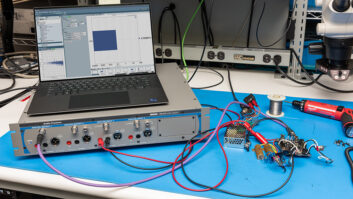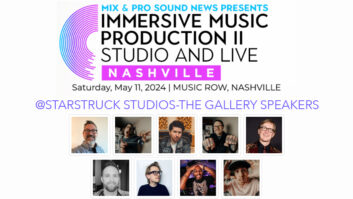
The ADAM Audio S2-A is a 2×150-watt (RMS) powered monitor with a 7.5-inch HexaCone Woofer and a 71-cm2 Accelerated Ribbon Technology (A.R.T.) tweeter. The manufacturer claims a wide bandwidth response (35 Hz to 35 kHz, ±3 dB), THD less than 0.6% (above 80 Hz) and maximum output of 109 dB (@ 1 m). Their size is compact at only 9×15×13 (W×H×D) inches, with weight about 28 pounds. The back panel includes a balanced XLR and a power switch. On the front, along with the bass port, there is a standby switch, input gain and three controls that allow users to tune the output for their listening environment. A High Gain control cuts or boosts the tweeter amplifier 4 dB and two Room EQ controls that are 6dB cut/boost shelf filters for above 6 kHz and below 150 Hz.
Dropping words like “HexaCone,” “Accelerated Ribbon Technology” and “Speed Transform Ratio,” the manufacturer’s spec sheet uses some pretty impressive terminology. HexaCone is a composite of Kevlar bonded to Nomex. Kevlar is used in bulletproof vests, and Nomex is used in fire suites. (Okay, I’m impressed: If a client doesn’t like the mix, we can actually shoot the monitor and not kill it.) HexaCone is supposed to be stiffer and lighter than conventional paper or polymer cones. The resulting combination of less weight and greater stiffness is supposed to produce a tight, smooth low- and mid-frequency response. Accelerated Ribbon Technology is radically different from coil-based transducers that are basically pistons moving air. The A.R.T. ribbon uses folded strips that squeeze air with the alternating current of the audio signal. ADAM Audio claims that the A.R.T. principle causes air to move in and out of the folds 4x faster than the folds themselves are moving (i.e., 4:1 speed transform ratio). The design is supposed to reduce mechanical resistance and provide improved transient response. Additionally, the ribbons’ larger surface area (as compared to dome tweeters) should allow smaller movement for a given sound pressure level and enable the tweeter to operate more efficiently without introducing dynamic compression.

Two simple questions: What is the loudspeaker capable of, and how well does a mix hold up when played on other loudspeakers? My tests had two parts: First, I took my SIA-Smaart test gear and a pair of S2-As to the Vanderbilt University acoustic research laboratory and borrowed their anechoic chamber (a specially designed room built for testing pure loudspeaker performance). There, I executed some basic frequency response tests to check their performance against the manufacturer’s spec sheet data. Then, I went to Ocean Way Nashville’s Studio A, remixed a 24-track master of a blues/rock band I cut a few years ago, and took that mix and played it on anything I could find to ensure the mix’s viability and the speaker’s performance reliability.
TESTING, 1, 2, 3
My goal in the anechoic chamber was to determine what effect the front-panel controls have on the signal, and if they would allow the loudspeaker to be tuned to produce a flat response across the audio spectrum. I placed a B&K calibrated test microphone one meter in front of the loudspeaker and performed 11 test sets, including a pair for each of the three front-panel controls: One had controls set to flat (the “0” setting) and one using the controls to try to produce a true flat response across the spectrum. With the controls in the “0” position, the S2-A’s output wasn’t exactly flat. However, it was within the manufacturer’s specification of ±3dB variance. On the bottom end, the overall response dropped off sharply below 55 Hz, a bit above the listed claim of 35 Hz. On the upper range, the A.R.T. tweeter was still kicking with no drop in signal, whereas my test gear stopped at 24 kHz; they claim response to be out to 35 kHz — we’ll give ’em that one. Overall, there was a rise of a few dB at 80 Hz, a little dip between 1.6 and 4.0 kHz, and another bump in output around 15 kHz. The High Gain control tended to cut at a lower frequency than it boosted, and the Room EQ Above 6 kHz control created a 6dB peak centered at about 10 kHz, rather than a true shelf that should continue above the turn frequency. I did find that the controls allowed me to tweak the response curve and get it fairly close to flat in the chamber (refer to red line in the graph).
IN THE STUDIO
At Ocean Way Nashville, I used my Nuendo/MOTU workstation as the source and placed the monitors at standard position over the Neve meter bridge, about two meters from the sweet spot. After positioning the monitors, I calibrated each to a listening level of 85 dBA and used the front controls to tweak the response to the best possible curve. The graph shows the result at the listening position: Note the dip at just below 1 kHz. I managed to get the top and bottom tweaked in pretty well, but it would’ve been nice to have a third Room EQ control to tune the midrange more accurately.
My first task was listening to familiar CDs from my collection: Sting, Bonnie Raitt, Yes and 10,000 Maniacs. I was immediately impressed with the clarity on the top and the tightness of the bass response. I can honestly say that my CDs have never sounded better. In fact, they sounded so good that my first thought was, “Okay, my mix will sound great here and terrible everywhere else.” However, when I started mixing, I found it unusually easy to EQ the instruments for blend. The kick drum and bass were tight and clear, and the top end was smooth and easy on my ears. In fact, I didn’t notice the dip in the midrange, and for the first time, I didn’t feel like I needed to EQ the toms and electric guitar to make them fit into the mix. In short, I was able to get a good reference mix after only about two hours, and it seemed to come fairly easily.
I took my CD reference anywhere I could. On the low end, I listened on two sets of multimedia computer speakers: one in my office at home and the other in my office on-site at Altec & Harmon. For a midrange comparison, I listened to Tannoy and Yamaha monitors at Belmont University; on the high end, it was JBL, KRK and Genelec (all self-powered) in the studios’ control rooms on Belmont’s campus. Okay, I am impressed. I can honestly say that everywhere I listened, the mix transferred surprisingly well. In short, I like ’em.
CONCLUSION
The S2-As performed exceptionally well even though my tests did not reflect results that were quite as good as the manufacturer claimed that they would be. Even so, if you’re looking for a high-end small studio reference monitor, the S2-As hold up with the best products currently on the market. For ADAM Audio, the combination of innovative design and high-tech materials has paid off quite well.
ADAM Audio, 805/413-1133, www.adam-audio.com.
Dr. Wesley Bulla is a freelance audio engineer and an associate professor in the Curb College of Entertainment and Music Business at Belmont University (Nashville).







